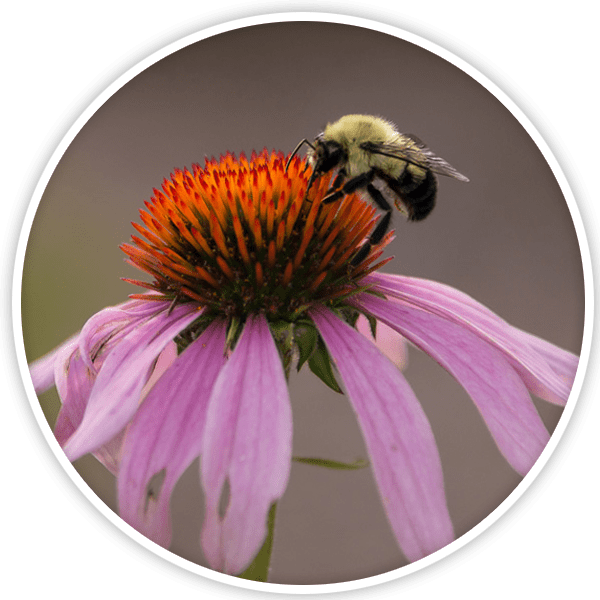
If you find yourself out on the McKinley Bridge Bikeway on a hot summer morning around 11 o’clock, don’t be shocked if you come across a group of college students wielding nets. They mean you no harm. They are only there for the bees.
These students are actually interns, conducting field research for a study of pollinator diversity within urban environments. The project, a partnership between the Biology Department of Saint Louis University and Great Rivers Greenway, is particularly interested in the diversity of the bee population within the city of St. Louis.
St. Louis, like many other cities around the world, has become a haven for bees. In fact, St. Louis is the home to more species of bees than any other city in North America. This increase in urban bee diversity is of particular interest to scientists, as bee diversity in more rural areas has been on the decline.
“When you look at plants, when you look at birds, when you look at mammals. Their overall diversity, as you get closer to the city, gets lower and lower and lower,” explained Gerardo Camilo, Associate Professor of Biology at Saint Louis University. “For bees, it is the opposite. Compared to the surrounding rural, suburban and agricultural sites, diversity is higher in the city environment.”
This poses two unique challenge to researchers and scientists – to first understand why bee populations are moving into the cities and then to figure out how to move them back to rural areas where they are needed most.
The Importance of Bee Diversity
“The total number of bees that you have, yes it is important, but how many different kinds of bees you have also matters a lot,” Camilo said.
“Different plant species will have different pollinators. It’s basic physics,” he explained. “A big bee weighs more and has bigger claws to dig into the flower, while smaller bees can’t do such things. A Bumble Bee is almost a hundred times bigger than a Sweat Bee, so even if the Sweat Bee tried with all its might, it may not be able to pull the pollen out of some plants.”
But it’s not just size that can be a factor. Some bees have developed specialized techniques for extracting pollen that are specific to their own species.
“On the south side, some community gardens stopped planting tomatoes. They were buying the plants and spending money on water and fertilizer and everything else, but they weren’t getting any tomatoes.”
As it turns out, this lack of growth was caused by a lack of Bumble Bees, and a specific pollination technique called “buzz pollination” through which these bees gain access to a plant’s pollen by vibrating their wings at just the right frequency.
“Of all the pollinators, bees are the only ones that intentionally collect pollen. Everyone else – hummingbirds, bats, butterflies – they gather the pollen accidentally,” Camilo said. “When it comes to humans, of the plants that we require for our own survival, over 99 percent of everything we eat or use for fiber – like cotton – comes from bee pollination.”
 Counting Bees
Counting Bees
To help gain a better understanding of what factors attract bees within the urban environment, Camilo and his team of interns – with nets in hand – have been paying regular visits to the pollinator gardens along the McKinley Bridge Bikeway and the Mary Meachum Freedom Crossing.
“It’s interesting to see the separation of what is living at each of these sites, even though they are only about a mile away from eachother,” said Alexandra Rader, one of the interns working on the pollinator project.
“I am particularly interested in plant biology, but bees and plants are completely intertwined,” Rader said. “St. Louis seems to be a hub of where the bees are going, and so we need to know why that is so we can learn from that and help bees succeed better in other locations.”
But to learn from the bees, the interns first have to catch them.
“We’ll go to different flowers and if we see a bee we’ll swing our net at it and catch it,” explained Jessica Von Bokel, one of the interns participating in the summer program. “We’ll take them back to the lab and identify the specific species at that specific location on that specific day.”
And they have no shortage of bees to study. On a good day, interns can collect over 200 individual bees, providing them with plenty of work for the lab.
The information from this project will help inform a global effort to understand this shift towards urbanized bees.
“I have colleagues in Detroit, Chicago, California, England and Australia, and despite all our efforts, we are all scratching our heads,” Camilo said. “We have seen this pattern all around the world. We are trying to come up with the right questions to ask. It takes us time to digest all this data, all this information, but in the mean-time we keep on sampling. The more bees we observe. The more crumbs we find to follow.”
Exactly where the crumbs will lead, Camilo is not certain, but the motivations for this work remains clear.
“We need bees. Right now, this is where the bees are. Ultimately, the goal is to understand what it is that we are doing in cities, and replicate it in the surrounding areas so their bee diversity comes up.”
